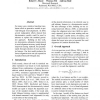138 search results - page 4 / 28 » Data Cleaning for Word Alignment |
LREC
2010
13 years 7 months ago
2010
This paper presents and evaluates an original approach to automatically align bitexts at the word level. It relies on a syntactic dependency analysis of the source and target text...
AMTA
2004
Springer
13 years 11 months ago
2004
Springer
Abstract. An adaptable statistical or hybrid MT system relies heavily on the quality of word-level alignments of real-world data. Statistical alignment approaches provide a reasona...
ACL
2004
13 years 7 months ago
2004
Supervised learning methods for WSD yield better performance than unsupervised methods. Yet the availability of clean training data for the former is still a severe challenge. In ...
SEMWEB
2007
Springer
13 years 12 months ago
2007
Springer
Potluck is a web user interface (Figure 1) that lets casual users— those without programming skills and data modeling expertise—merge and repurpose heterogeneous Semantic Web d...
ACL
2006
13 years 7 months ago
2006
For many years, statistical machine translation relied on generative models to provide bilingual word alignments. In 2005, several independent efforts showed that discriminative m...

